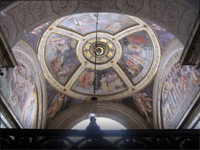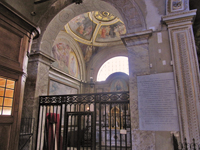ANTONIO GHERARDI
Antonio Tatoti was one of the most original artists of the Baroque age.
He was born in Rieti in 1638.
He owes his artistic fortunes to Monsignor Bulgarino Bulgarini, the governor of Rieti, that in those times was in the Papal States. His father, a shoemaker, died when Antonio was eight years old. In 1657 Bulgarini was transferred to Rome, where shortly after was reached by our Antonio, who in 1660 wanted to change his name to Gherardi and as Antonio Gherardi is known. Bulgarini introduced him in the Roman art world, presenting Antonio to the painter Pier Francesco Mola and the great Pietro da Cortona, who influenced decisively Gherardi, so much that his first paintings were long attributed to Pietro. Between 1667 and 1669 he made a study trip that took him to Bologna, Milan, Venice and, returning to Rome, Perugia.
On his return he was commissioned for the church of Santa Maria in Trivio (close to the Trevi Fountain) his first great work: the painting of the vault representing the story of the life of the Virgin.
In the following years he worked for the Roman nobility.
From 1675, we could say inspired by Pietro da Cortona, he became painter, architect and sculptor. Just in 1675 was inaugurated in Santa Maria in Aracoeli the chapel of St. Francis Solano where Gherardi was precisely architect and painter.
About the paintings survived only the large lunette with the death of the saint and two small frescoes on the ceiling.
 |
 |
 |
| The chapel of St. Francis Solano - click to enlarge |
Around 1680 he completed the chapel Avila, in the church of Santa Maria in Trastevere. We know, however, that since 1673 he lived in the palace of the patron, Pietro Paolo Avila.
This masterpiece is his most daring and original, so much that the abbot Filippo Titi, author of a guide in Rome, shocked by such a boldness, called this architecture “bizarre and capricious”.
Actually the chapel is extraordinary for the perspective illusionism after Borromini style and the play of light projected from the dome supported by four angels.
Even the picture on the high altar, depicting St. Jerome in the desert, is by Gherardi.
In 1691 he was entrusted with the construction of the chapel of Santa Cecilia in San Carlo ai Catinari.
Meanwhile he worked in many places of Lazio and Umbria.
The chapel of Santa Cecilia is perhaps his most challenging work since Gherardi oversaw the architecture, stucco and painted the altarpiece.
The scenic composition culminated with two superimposed cupolas,
that create amazing light effects, coming down to illuminate the stucco.
Even the altarpiece, depicting Santa Cecilia is by Gherardi, below Antonio portrayed his children as musician angels. Note in the dome other musician angels playing in honor of St. Cecilia.
Around 1697 he was entrusted with the restoration of the chapel of Santa Teresa at Santa Maria in Traspontina, here beyond the architecture and design of the stucco he painted the altar with the Ecstasy of Santa Teresa.
Antonio Gherardi died in Rome in 1702. He was buried in the Basilica of Santa Maria sopra Minerva.
In this our journey inside the Baroque age, we included Gherardi among architects for his unforgettable “inventions”: Avila and Santa Cecilia chapels.
back |

